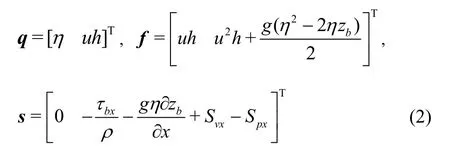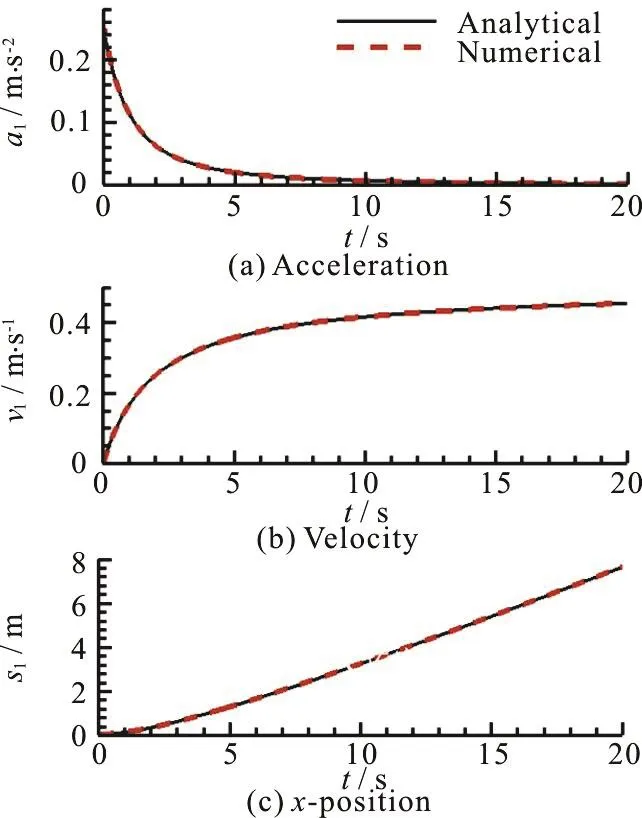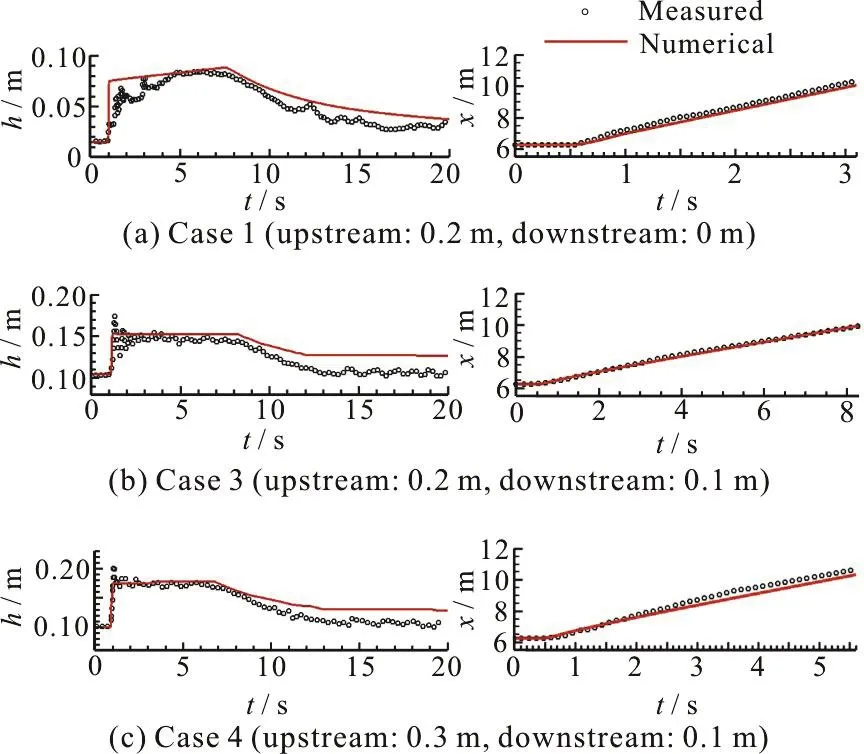A novel two-way method for dynamically coupling a hydrodynamic model with a discrete element model (DEM) *
2018-10-27YanXiong熊焱QiuhuaLiangSamanthaMahaffeyMohamedRouainiaGangWang王岗
Yan Xiong (熊焱), Qiuhua Liang , , Samantha Mahaffey , Mohamed Rouainia , Gang Wang (王岗)
1. State Key Laboratory of Hydrology-Water Resources and Hydraulic Engineering, Hohai University, Nanjing 210098, China
2. School of Architecture, Building and Civil Engineering, Loughborough University, Loughborough, UK
3. School of Engineering, Newcastle University, Newcastle upon Tyne, England, UK
Abstract: The effect of floating objects has so far been little considered for hazard risk assessment and structure design, despite being an important factor causing structural damage in flood-prone and coastal areas.In this work, a novel two-way method is proposed to fully couple a shock-capturing hydrodynamic model with a discrete element model (DEM) for simulation of complex debris-enriched flow hydrodynamics.After being validated against an idealized analytical test, the new coupled model is used to reproduce flume experiments of floating debris driven by dam-break waves.The numerical results agree satisfactorily with the experimental measurements, demonstrating the model’s capability and efficiency in simulating complex fluid-debris interactions induced by violent shallow flows.
Key words: Coupled model, discrete element model (DEM), extreme hydraulic conditions, floating debris, shallow water equations,Godunov-type finite volume method
In recent years, extreme water-related natural hazards, e.g.flash floods, tsunamis and storm surges,have become more frequent and attracted increasing attention from the public, scientists and other relevant communities.One of the striking features of these water-related events is that dense floating debris, of all shapes and sizes, may be carried along by the highly transient water flows.Many field investigations imply that water flow alone is much less destructive than debris-enriched flow during a hazard event[1].However, the role of floating objects has not been adequately considered in the risk assessment frameworks and the design codes in flood-prone and coastal areas although new research in the topic has become increasingly reported in recent years[2-3].
Numerical modelling has become an indispensable tool for simulation of the interactive dynamics between fluid flows and floating objects.This is usually achieved by coupling two different types of models using one of the three types of coupling methods: one-way solid-to-fluid coupling, one-way fluid-to-solid coupling, and two-way dynamic coupling[4].Both types of one-way coupled models do not consider the feedback of the recipient phase to the driving phase, and are only applicable to certain simple cases where the dynamics of either the fluid or the solid phase is less predominant than the interaction between them.
Two-way dynamic coupling methods take into account the dynamic interaction between the fluid flow and solids.Whilst the fluid flow moves the solids,the motion of the solids imposes counter forces/effects on the fluid and changes its dynamics.Researchers have attempted to develop two-way coupled models for fluid-solid interaction problems using hydraulic models and force analysis methods[5].A force analysis method considers buoyant force and drag force as the two most representative forces determining the interaction between fluid and solid[6].The drag force is normally estimated using empirical formulas containing a drag coefficient,CD.Expressions/values ofCDare normally provided empirically according to the shape of the object under consideration and flow conditions[7].Although certain models adopting this approach have been reported to be successful in simulating specific types of floating objects[8-10], the floating objects observed during a tsunami or extreme flood event are much more complex and may come in different shapes and sizes.Furthermore, the value of the drag coefficient for calculating drag force is normally estimated using empirical formulas or values suggested by physical experiments under idealized flow conditions.There is no reliable approach to accurately quantify drag coefficient for the simulation of various floating debris in highly transient flow conditions during an extreme flood event.Therefore,there is a clear research gap and need in the development of computationally more efficient models for accurate prediction of complex fluid-debris dynamics driven by violent shallow water flows.
This letter aims to briefly introduce our innovative but preliminary work of developing a novel two-way coupled model for simulating debrisenriched shallow flows.The coupled model consists of a shock-capturing hydrodynamic model solving the shallow water equations (SWEs) and a discrete element model (DEM) for predicting the movement of floating debris.In order to avoid using parameterized drag force to foster the coupling, the fluid-solid interaction is encapsulated through hydrostatic and hydrodynamic pressure forces, which is consistent with the shallow water theory.This new two-way dynamic coupling approach effectively avoids introducing unresolved parameters (e.g., drag coefficient) for force calculation and is suitable for simulating complex environmental flows with highly transient flow conditions.
For shallow flows with dominated dynamics in one spatial dimension, the 1-D SWEs may be written in a matrix form as

wheretandxrepresent respectively the time and horizontal coordinate, andq,fandsare the vectors containing the flow variables, fluxes and source terms.The vector terms are provided as follows:

whereηandzbrepresent the water surface elevation and bed elevation above datum withh=η-zbbeing the total water depth,uis the depth-averaged velocity,gis the acceleration due to gravity,ρdenotes the water density,defines the bed slope in thex-direction,τbxis the bed friction stress,Svxis the turbulent (viscous) term; andSpxcontains the extra forces (stresses) to facilitate the coupling with a DEM model.Herein, the governing SWEs are solved using a second-order finite volume Godunov-type scheme implemented with an HLL approximate Riemann solver for evaluating interface fluxes.The second-order accuracy in both space and time is achieved through a two-step MUSCL-Hancock method.Detailed implementation of the numerical method can be found in Ref.[11].
For the adopted DEM model, the following discretized equations are used to calculate the translational and rotational motions of the elements:

whereiis the index of the elements/particles,miandIiare the mass and moment of elementi,wiandωiare the velocity and angular velocity,p iFis the sum of contact forces acting on elementiby other elements or fixed structures,represents the vertical gravity force, andis the forces acting on the elementiby the surrounding fluid,p iTandare torques acting on the centroid of elementi,respectivelygenerated byand.The combined forces and torques are used to calculate the acceleration, velocity and displacement of a particle/object at every time step.In this study, circles or spheres are adopted to idealize the floating objects.
The fluid forces are consisted of buoyancy,,and the sum of hydrostatic and hydrodynamic forces,The joint forces (vectors) are used to couple the SWE model with the DEM model, i.e.

In the vertical direction, the buoyancy is calculated as

whereViis the volume of fluid displaced by the particle/elementi.The buoyancy will be also compared with the gravity to determine the vertical position of elementirelative to the fluid surface,e.g., “completely submerged” or “floated”.This will accordingly allow the derivation of the submerged area for fluid impact calculation.
In the horizontal direction, hydrostatic and hydrodynamic forces are calculated from the flow variables predicted by the SWE model.Firstly, the total pressureat an arbitrary point on particleiis given by

The total fluid impact that moves the debris/particle can be then obtained as follows

where the subscripts,BandF, indicate the “Back”and “Front” of the particle, andSBandSFare the areas of the “Back” side and “Front” side of the particle that are submerged in the water, which is calculated after the vertical position of the particle is determined according to the relationship betweenand gravity.
When coupling the SWE model with the DEM,only the horizontal forces are necessary to be considered and the joint counter-force/stress added to the source terms in Eq.(2) is given by

The new two-way coupled model is validated against an analytical test, and then applied to reproduce dam-break flume experiments with floating objects.The idealized case of an initially stagnant solid ball moving by a slow steady flow is first considered to test the new fluid-solid coupled model.The ball is assumed to float in the water from the start of the simulation, with the buoyancy equal to gravity.For slow steady flows, the water levels at the “front”and “back” of the ball may be assumed to be identical,leading toSB=SF.Therefore, the static component of the fluid pressure force is 0.The total fluid impact on the ball is therefore equal to the dynamic component of the pressure force.Subsequently the velocity of the ball is analytically derived as

Assuming the initial location of the ball iss0,the displacementand accelerationcan be also analytically derived and given as follows:

During the simulation, the steady flow is assumed to have a constant water depth of 0.4 m and velocity of 0.5 m/s in a 20 m flume.A small ball of radius 0.02 m and density 500 kg/m3is released instantly att=0 at a location 0.5 m from the left boundary (i.e.,s0=0.5m).The numerical results in terms of acceleration,velocity andx-position of the ball are presented in Fig.1 and compared with the analytical solutions.The numerical predictions agree perfectly well with analytical solutions, confirming that the new two-way coupling method can effectively simulate the motion of floating solids driven by simple steady flows.

Fig.1 (Color online) Comparison of numerical and analytical solutions for a solid ball moving in a steady flow
A series of flume experiments have been designed and carried out to investigate the interaction between floating debris and flows at the hydraulic laboratory in Hohai University, China.Details of the experiment set up for dam breaks without debris can be found in Ref.[13].Herein, three experimental tests with different debris (wooden sticks) and different water depths upstream and downstream of the dam are selected and reproduced by the current coupled SWE-DEM model.
The predicted and measured time series of water depth and position of the floating objects are compared in Fig.2.Both of the water depths andx-positions of the debris are satisfactorily simulated and compared reasonably well with the measurements.Particularly,the arrival times and peak water levels of the dam break waves are all well predicted.The moments when the objects being picked up are also correctly captured in all of the tests.The slight overestimation of the water level at final equilibrium state may be caused by the limitation of the over-simplified 1-D SWE model for simulation of highly dynamic dam-break waves.But the movement of the floating objects is dominated by advancing wave front and less relevant to the final state of the flow.The predicted trajectories of floating objects do not seem to be affected by the less accurate prediction of the final stage steady flow.Successful reproduction of these experimental tests demonstrates the model’s capability in simulating the complex behaviours of floating debris driven by violent dam-break flows.

Fig.2 (Color online) Predicted and measures time serious of water depth and x-position of floating object
In this work, a new two-way coupling approach is proposed to dynamically couple a 1-D SWE model with a DEM to simulate the complex behaviours of floating debris driven by highly transient shallow flows.Within the proposed two-way coupling framework, a 1-D shock-capturing SWE numerical model is fully coupled to a DEM through buoyancy, hydrostatic and hydrodynamic forces.The resulting coupled model is then validated against analytical and experimental test cases with satisfactory results obtained.This preliminarily demonstrates the validity of the coupling approach and capability of the resulting model to accurately capture the highly complex dynamics of the floating objects driven by violent shallow flows.More systematic model validation is currently being undertaken and will be reported in the forthcoming full paper.The model can also be readily extended to 2-D for wider applications, especially for large-scale simulation of floating debris driven by flash floods, storm surges or tsunamis.This will be achieved in future work.
杂志排行
水动力学研究与进展 B辑的其它文章
- Call For Papers The 3rd International Symposium of Cavitation and Multiphase Flow
- Air entrainment of hydraulic jump aeration basin *
- Shallow-water sloshing motions in rectangular tank in general motions based on Boussinesq-type equations *
- Fundamental diagrams for pedestrian flows in a channel via an extended social force model *
- Axial laminar velocity field calculation and optimization for power-law fluid in eccentric annulus with cutting bed *
- Numerical modeling of sediment transport based on unsteady and steady flows by incompressible smoothed particle hydrodynamics method *
